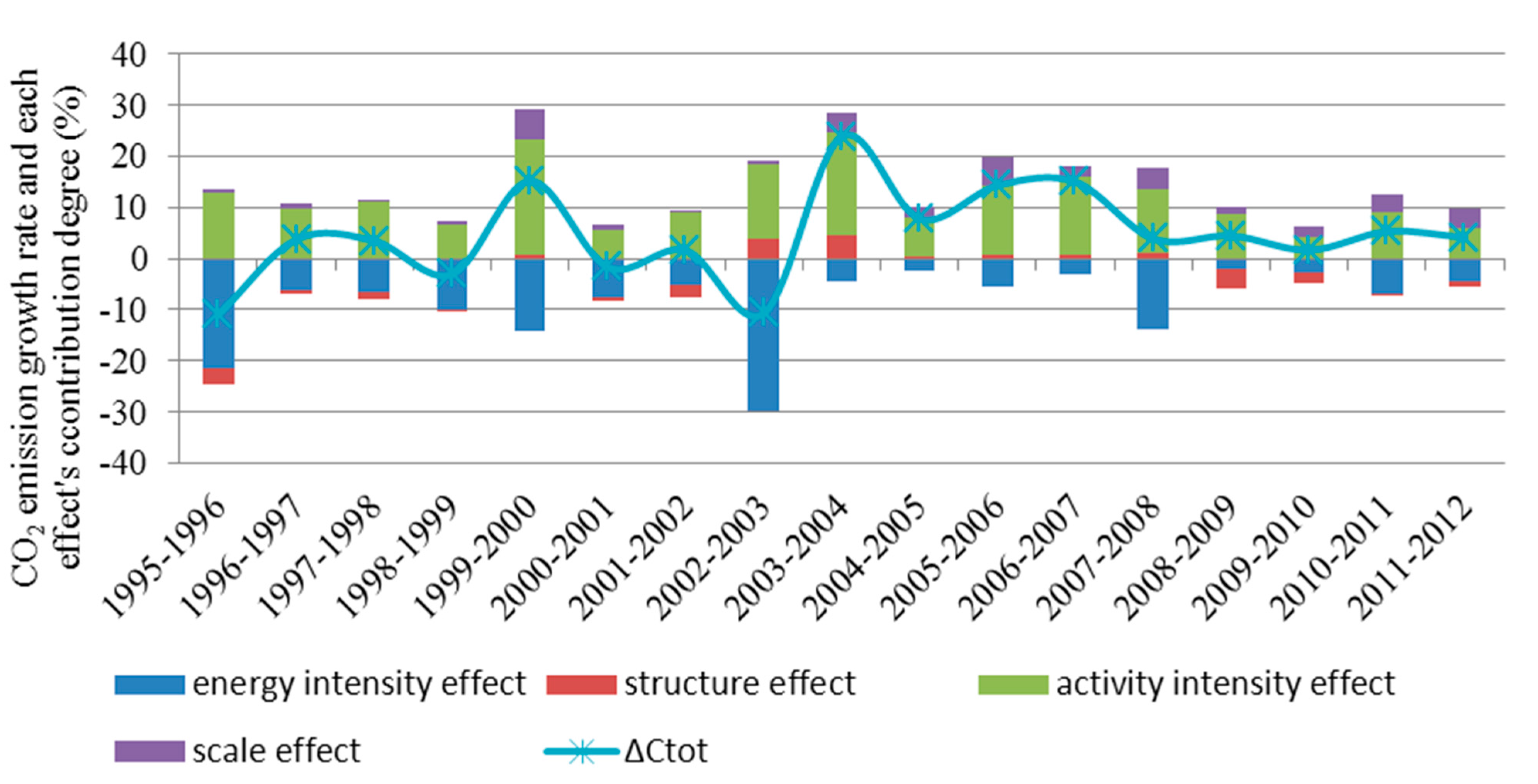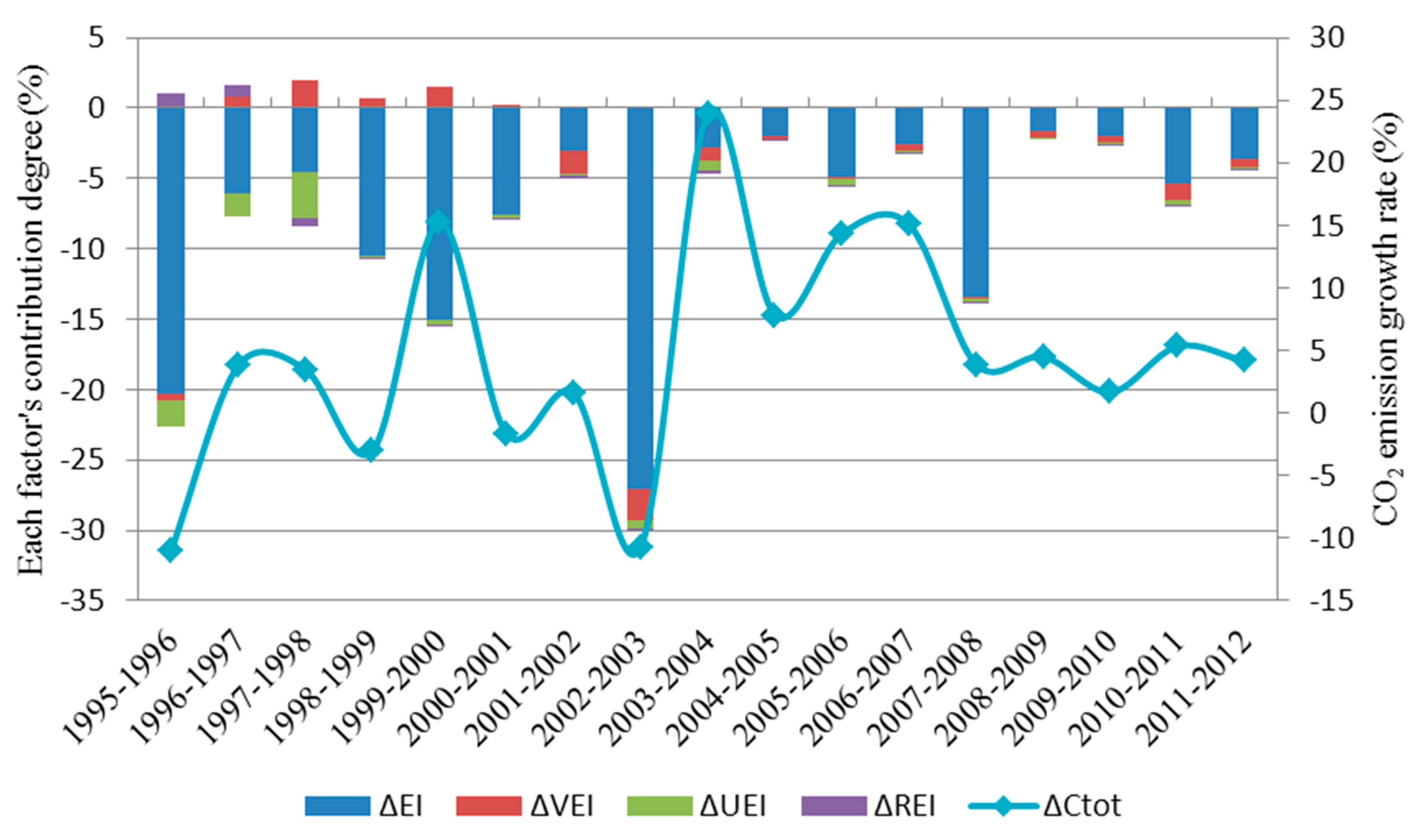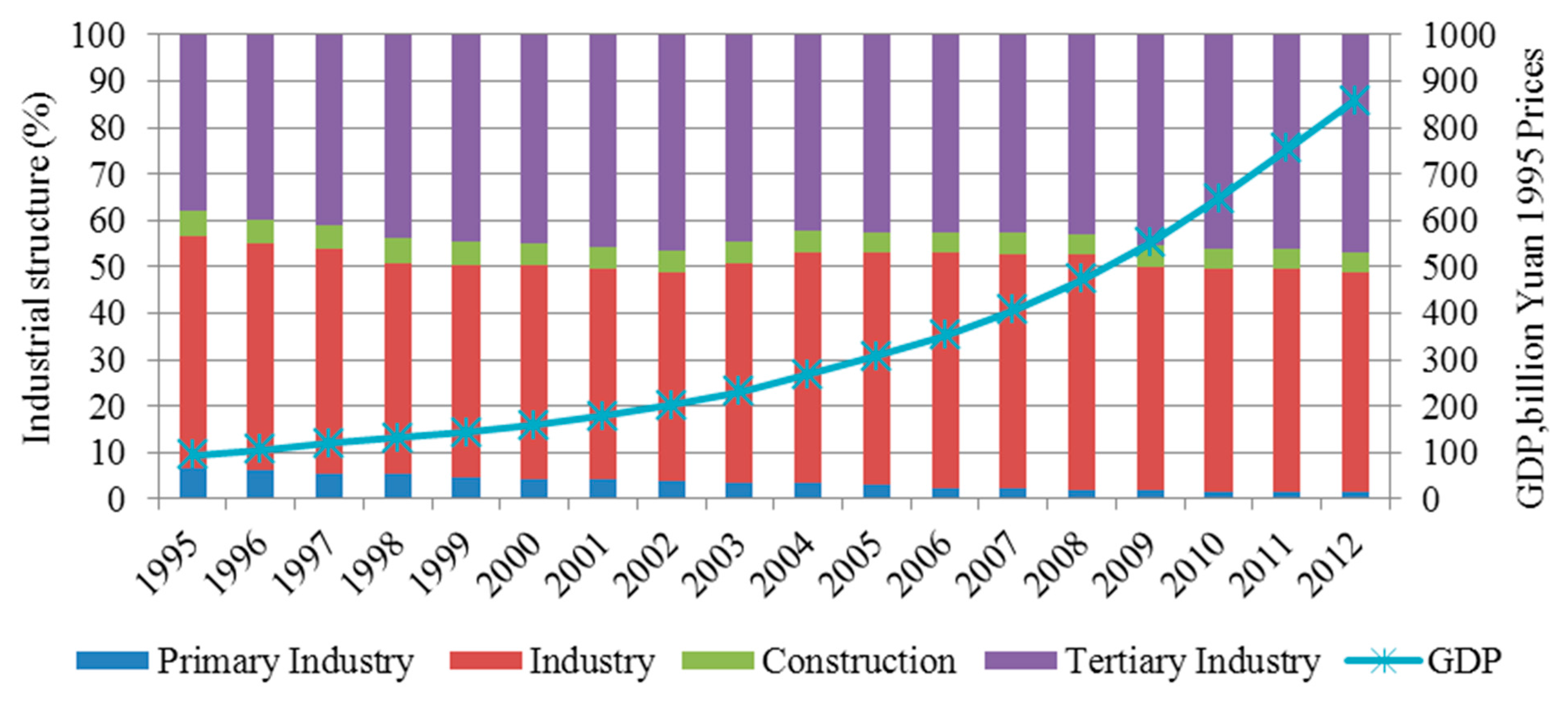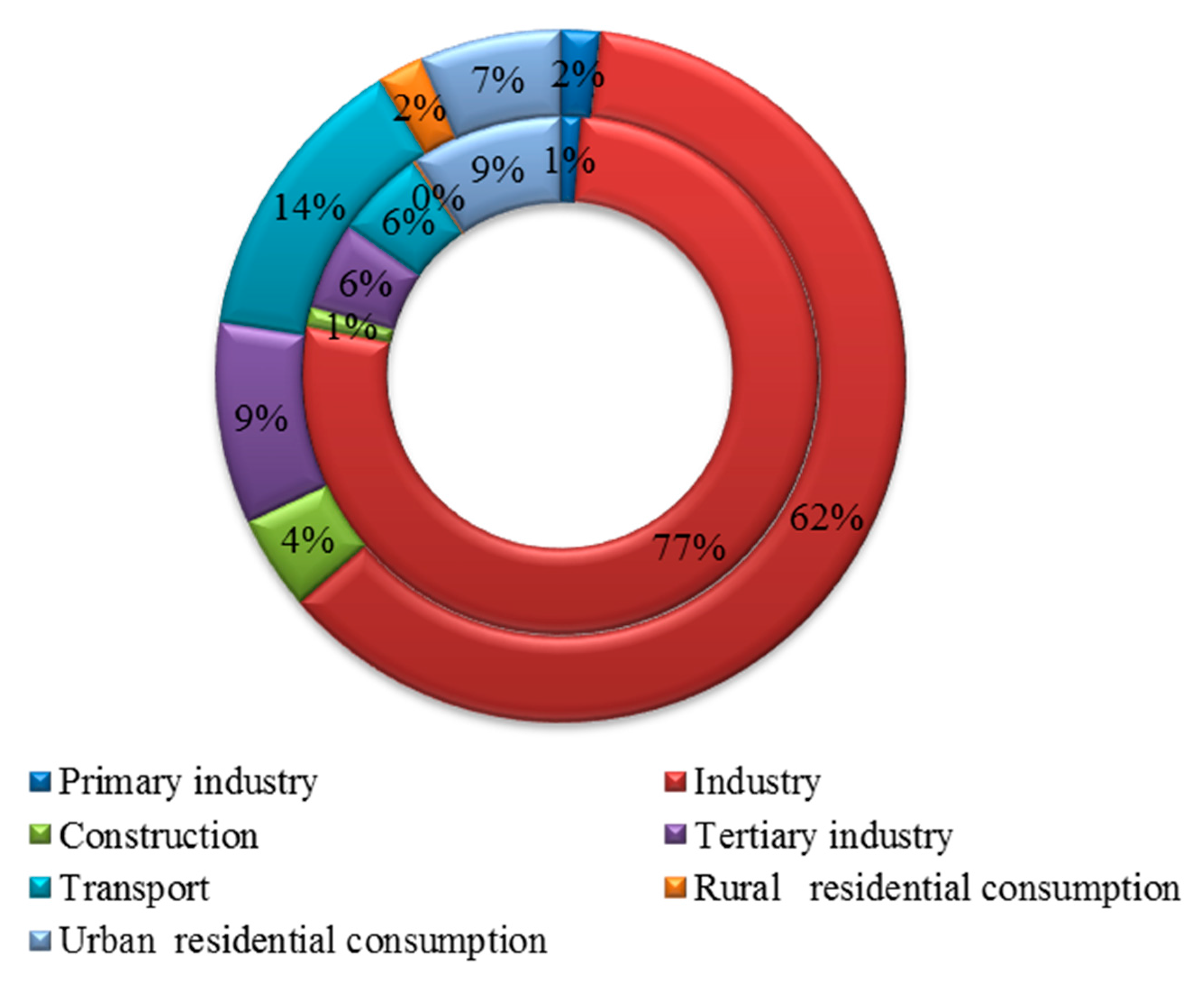Factor Decomposition Analysis of Energy-Related CO2 Emissions in Tianjin, China
Abstract
:1. Introduction
2. Methodology and Data
2.1. The Logarithmic Mean Divisia Index (LMDI) Decomposition Model
2.2. Data Sources
3. Results and Discussion
| Time Period | ΔEI | ΔVEI | ΔUEI | ΔREI | ΔES | ΔIS | ΔUR | ΔGPC | ΔUIPC | ΔVNC | ΔP | ΔTRI | ΔCtot |
|---|---|---|---|---|---|---|---|---|---|---|---|---|---|
| 1995–1996 | −7.27 | −0.16 | −0.66 | 0.37 | −0.04 | −1.11 | 0.01 | 3.61 | 0.51 | 0.49 | 0.29 | 0.04 | −3.95 |
| 1996–1997 | −1.93 | 0.27 | −0.55 | 0.24 | 0.18 | −0.45 | 0.02 | 2.48 | 0.27 | 0.40 | 0.26 | 0.01 | 1.21 |
| 1997–1998 | −1.50 | 0.65 | −1.08 | −0.20 | 0.24 | −0.81 | 0.02 | 3.36 | 0.19 | 0.17 | 0.08 | 0.02 | 1.16 |
| 1998–1999 | −3.60 | 0.24 | −0.04 | −0.01 | −0.17 | −0.03 | 0.01 | 1.98 | 0.17 | 0.10 | 0.25 | 0.05 | −1.04 |
| 1999–2000 | −4.99 | 0.50 | −0.11 | −0.07 | −0.20 | 0.34 | 0.05 | 6.81 | 0.31 | 0.42 | 1.95 | 0.06 | 5.06 |
| 2000–2001 | −2.89 | 0.10 | −0.11 | −0.03 | −0.17 | −0.08 | 0.01 | 2.06 | 0.13 | 0.02 | 0.20 | 0.12 | −0.64 |
| 2001–2002 | −1.15 | −0.62 | −0.06 | −0.08 | −0.74 | −0.26 | 0.00 | 2.17 | 0.09 | 1.18 | 0.04 | 0.02 | 0.61 |
| 2002–2003 | −10.34 | −0.86 | −0.22 | −0.04 | 0.93 | 0.49 | 0.04 | 3.98 | 0.13 | 1.47 | 0.29 | 0.03 | −4.10 |
| 2003–2004 | −0.96 | −0.33 | −0.23 | −0.07 | 0.19 | 1.39 | 0.01 | 5.98 | 0.25 | 0.64 | 1.20 | 0.12 | 8.19 |
| 2004–2005 | −0.87 | −0.06 | −0.03 | −0.04 | −0.17 | 0.39 | 0.01 | 2.88 | 0.16 | 0.18 | 0.82 | 0.06 | 3.32 |
| 2005–2006 | −2.26 | −0.02 | −0.20 | −0.04 | 0.09 | 0.14 | 0.03 | 5.62 | 0.27 | 0.44 | 2.39 | 0.09 | 6.55 |
| 2006–2007 | −1.34 | −0.27 | −0.02 | −0.01 | 0.31 | 0.07 | 0.05 | 7.20 | 0.41 | 0.25 | 1.06 | 0.15 | 7.86 |
| 2007–2008 | −8.04 | −0.11 | −0.14 | −0.05 | 0.23 | 0.44 | 0.04 | 6.38 | 0.60 | 0.40 | 2.49 | 0.10 | 2.34 |
| 2008–2009 | −1.05 | −0.27 | −0.06 | 0.02 | −0.73 | −1.58 | 0.06 | 4.35 | 0.35 | 0.64 | 0.95 | 0.13 | 2.81 |
| 2009–2010 | −1.27 | −0.32 | −0.11 | −0.09 | −0.38 | −0.93 | 0.05 | 2.04 | 0.27 | 0.37 | 1.40 | 0.07 | 1.10 |
| 2010–2011 | −3.58 | −0.77 | −0.19 | −0.02 | −0.18 | −0.09 | 0.12 | 4.25 | 1.00 | 0.87 | 1.87 | 0.27 | 3.55 |
| 2011–2012 | −2.49 | −0.45 | −0.04 | −0.01 | −0.60 | −0.38 | 0.15 | 3.19 | 0.80 | 0.22 | 2.36 | 0.17 | 2.92 |
| 1995–2012 | −55.50 | −2.49 | −3.86 | −0.14 | −1.20 | −2.46 | 0.66 | 68.35 | 5.93 | 8.26 | 17.89 | 1.50 | 36.93 |

3.1. Energy Intensity Effect

3.2. Structure Effect



3.3. Activity Intensity Effect
3.4. Scale Effect
4. Conclusions and Policy Recommendations
Author Contributions
Conflicts of Interest
References
- BP. Bp Statistical Review of World Energy 2013; BP Company: London, UK, 2013. [Google Scholar]
- Boden, T.A.; Marland, G.; Andres, R.J. Global, Regional, and National Fossil-fuel CO2 Emissions; Carbon Dioxide Information Analysis Center: Oak Ridge, TN, USA, 2012. [Google Scholar]
- Agee, M.D.; Atkinson, S.E.; Thomas, D.C.; Williams, J.W. Non-separable pollution control: Implications for a CO2 emissions cap and trade system. Resour. Energy Econ. 2014, 36, 64–82. [Google Scholar] [CrossRef]
- Accord, C. China’s Autonomous Domestic Mitigation Actions. Available online: https://unfccc.int/files/meetings/cop_15/copenhagen_accord/application/pdf/chinacphaccord_app2.pdf (accessed on 28 January 2010).
- National Bureau of Statistics of China (NBSC). China Statistical Yearbook 2013; China Statistics Press: Beijing, China, 2013.
- Dhakal, S. Urban energy use and carbon emissions from cities in China and policy implications. Energy Policy 2009, 37, 4208–4219. [Google Scholar] [CrossRef]
- Wang, Y.; Zhao, H.; Li, L.; Liu, Z.; Liang, S. Carbon dioxide emission drivers for a typical metropolis using input-output structural decomposition analysis. Energy Policy 2013, 58, 312–318. [Google Scholar] [CrossRef]
- Tan, Z.F.; Li, L.; Wang, J.J.; Wang, J.H. Examining the driving forces for improving China’s CO2 emission intensity using the decomposing method. Appl. Energy 2011, 88, 4496–4504. [Google Scholar] [CrossRef]
- Liu, Z.; Liang, S.; Geng, Y.; Xue, B.; Xi, F.; Pan, Y.; Zhang, T.; Fujita, T. Features, trajectories and driving forces for energy-related ghg emissions from Chinese mega cites: The case of Beijing, Tianjin, Shanghai and Chongqing. Energy 2012, 37, 245–254. [Google Scholar] [CrossRef]
- Guan, D.; Hubacek, K.; Weber, C.L.; Peters, G.P.; Reiner, D.M. The drivers of Chinese CO2 emissions from 1980 to 2030. Glob. Environ. Change 2008, 18, 626–634. [Google Scholar] [CrossRef]
- Wang, C.; Chen, J.N.; Zou, J. Decomposition of energy-related CO2 emission in China: 1957–2000. Energy 2005, 30, 73–83. [Google Scholar] [CrossRef]
- Chen, L.; Yang, Z.F.; Chen, B. Decomposition analysis of energy-related industrial CO2 emissions in China. Energies 2013, 6, 2319–2337. [Google Scholar] [CrossRef]
- Tianjin Municipal Bureau of Statistics. Tianjin Statistical Yearbook 2013; China Statistics Press: Beijing, China, 2013.
- Liu, F.L.; Ang, B.W. Eight methods for decomposing the aggregate energy-intensity of industry. Appl. Energy 2003, 76, 15–23. [Google Scholar] [CrossRef]
- Cellura, M.; Longo, S.; Mistretta, M. Application of the structural decomposition analysis to assess the indirect energy consumption and air emission changes related to italian households consumption. Renew. Sustain. Energy Rev. 2012, 16, 1135–1145. [Google Scholar] [CrossRef]
- Zhang, Y.J.; Da, Y.B. The decomposition of energy-related carbon emission and its decoupling with economic growth in china. Renew. Sustain. Energy Rev. 2015, 41, 1255–1266. [Google Scholar] [CrossRef]
- Ang, B.W. Decomposition analysis for policymaking in energy. Energy Policy 2004, 32, 1131–1139. [Google Scholar] [CrossRef]
- Ang, B.W.; Zhang, F.Q. A survey of index decomposition analysis in energy and environmental studies. Energy 2000, 25, 1149–1176. [Google Scholar] [CrossRef]
- Ang, B.W.; Choi, K.H. Decomposition of aggregate energy and gas emission intensities for industry: A refined divisia index method. Energy J. 1997, 18, 59–73. [Google Scholar] [CrossRef]
- Ang, B.W.; Liu, F.L. A new energy decomposition method: Perfect in decomposition and consistent in aggregation. Energy 2001, 26, 537–548. [Google Scholar] [CrossRef]
- Ang, B.W.; Liu, N. Handling zero values in the logarithmic mean divisia index decomposition approach. Energy Policy 2007, 35, 238–246. [Google Scholar] [CrossRef]
- Ang, B.W. The lmdi approach to decomposition analysis: A practical guide. Energy Policy 2005, 33, 867–871. [Google Scholar] [CrossRef]
- Liu, L.C.; Fan, Y.; Wu, G.; Wei, Y.M. Using lmdi method to analyzed the change of China’s industrial CO2 emissions from final fuel use: An empirical analysis. Energy Policy 2007, 35, 5892–5900. [Google Scholar] [CrossRef]
- Wu, J.H.; Chen, Y.Y.; Huang, Y.H. Trade pattern change impact on industrial CO2 emissions in Taiwan. Energy Policy 2007, 35, 5436–5446. [Google Scholar] [CrossRef]
- Fernandez Gonzalez, P.; Landajo, M.; Presno, M.J. Multilevel lmdi decomposition of changes in aggregate energy consumption. A cross country analysis in the EU-27. Energy Policy 2014, 68, 576–584. [Google Scholar] [CrossRef]
- O’Mahony, T. Decomposition of Ireland’s carbon emissions from 1990 to 2010: An extended kaya identity. Energy Policy 2013, 59, 573–581. [Google Scholar]
- Tian, Y.H.; Zhu, Q.H.; Geng, Y. An analysis of energy-related greenhouse gas emissions in the Chinese iron and steel industry. Energy Policy 2013, 56, 352–361. [Google Scholar] [CrossRef]
- Wang, C.J.; Wang, F.; Zhang, H.G.; Ye, Y.Y.; Wu, Q.T.; Su, Y.X. Carbon emissions decomposition and environmental mitigation policy recommendations for sustainable development in Shandong province. Sustainability 2014, 6, 8164–8179. [Google Scholar] [CrossRef]
- Guo, B.; Geng, Y.; Franke, B.; Hao, H.; Liu, Y.; Chiu, A. Uncovering China’s transport CO2 emission patterns at the regional level. Energy Policy 2014, 74, 134–146. [Google Scholar] [CrossRef]
- Xu, J.H.; Fleiter, T.; Eichhammer, W.; Fan, Y. Energy consumption and CO2 emissions in China’s cement industry: A perspective from lmdi decomposition analysis. Energy Policy 2012, 50, 821–832. [Google Scholar] [CrossRef]
- Lin, B.Q.; Ouyang, X.L. Analysis of energy-related CO2 (carbon dioxide) emissions and reduction potential in the Chinese non-metallic mineral products industry. Energy 2014, 68, 688–697. [Google Scholar] [CrossRef]
- Baldwin, J.G.; Wing, I.S. The spatiotemporal evolution of U.S. Carbon dioxide emissions: Stylized facts and implications for climate policy. J. Reg. Sci. 2013, 53, 672–689. [Google Scholar] [CrossRef]
- Intergovernmental Panel on Climate Change (IPCC). 2006 IPCC Guidelines for National Greenhouse Gas Inventories [db/ol]. Available online: http://www.ipcc-nggip.iges.or.jp/public/2006gl/index.html (accessed on 1 May 2015).
- Ma, C.; Stern, D.I. Biomass and China’s carbon emissions: A missing piece of carbon decomposition. Energy Policy 2008, 36, 2517–2526. [Google Scholar] [CrossRef]
- Chen, Y.; Lin, S. Study on factors affecting energy-related per capita carbon dioxide emission by multi-sectoral of cities: A case study of Tianjin. Nat. Hazards 2015, 77, 833–846. [Google Scholar] [CrossRef]
- Wang, Z.H.; Yang, L. Delinking indicators on regional industry development and carbon emissions: Beijing-Tianjin-Hebei economic band case. Ecol. Indic. 2015, 48, 41–48. [Google Scholar] [CrossRef]
- Kang, J.; Zhao, T.; Liu, N.; Zhang, X.; Xu, X.; Lin, T. A multi-sectoral decomposition analysis of city-level greenhouse gas emissions: Case study of Tianjin, China. Energy 2014, 68, 562–571. [Google Scholar] [CrossRef]
- Wang, W.W.; Liu, R.; Zhang, M.; Li, H.A. Decomposing the decoupling of energy-related CO2 emissions and economic growth in Jiangsu province. Energy Sustain. Dev. 2013, 17, 62–71. [Google Scholar] [CrossRef]
© 2015 by the authors; licensee MDPI, Basel, Switzerland. This article is an open access article distributed under the terms and conditions of the Creative Commons Attribution license (http://creativecommons.org/licenses/by/4.0/).
Share and Cite
Wang, Z.; Zhao, L.; Mao, G.; Wu, B. Factor Decomposition Analysis of Energy-Related CO2 Emissions in Tianjin, China. Sustainability 2015, 7, 9973-9988. https://doi.org/10.3390/su7089973
Wang Z, Zhao L, Mao G, Wu B. Factor Decomposition Analysis of Energy-Related CO2 Emissions in Tianjin, China. Sustainability. 2015; 7(8):9973-9988. https://doi.org/10.3390/su7089973
Chicago/Turabian StyleWang, Zhe, Lin Zhao, Guozhu Mao, and Ben Wu. 2015. "Factor Decomposition Analysis of Energy-Related CO2 Emissions in Tianjin, China" Sustainability 7, no. 8: 9973-9988. https://doi.org/10.3390/su7089973





